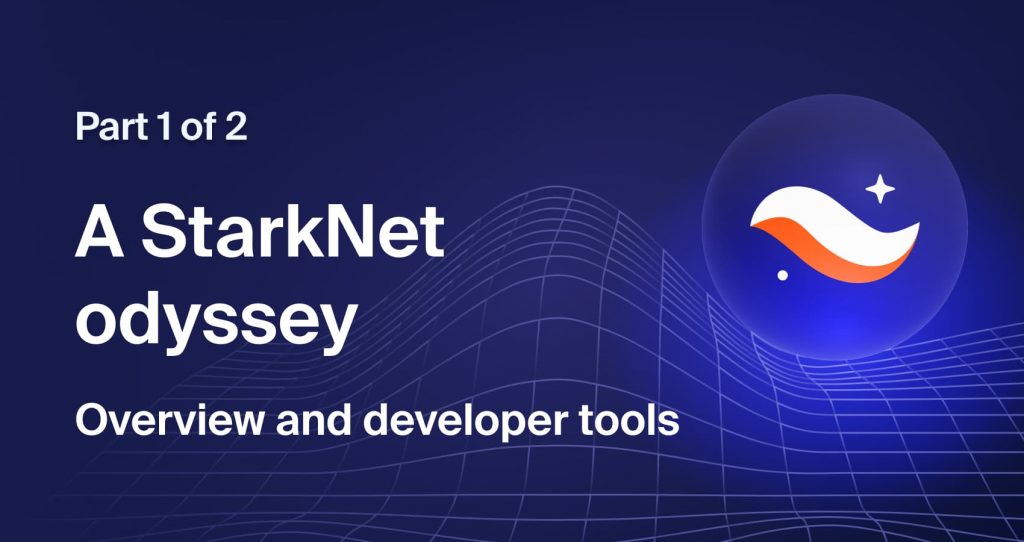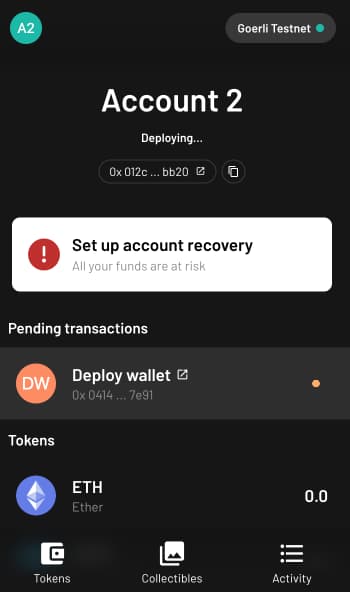StarkNet – Overview of developer tools and zk-rollups

StarkNet is a network for general purpose contracts written in Cairo, and its mainnet has been live since December 2021. It is one of the most popular L2 solutions today and the latest protocol supported by Chainstack.
The enthusiasm behind this project is huge. During the past few months, I’ve been reading articles, tweets, and I even met some of the StarkWare team members, so I decided to do some research and try to write a contract that runs on StarkNet.
However, before any of that, I knew that if I wanted to understand why Layer 2 solutions are so popular, first I needed to know the problem they solve and how they do it. That’s where the StarkNet odyssey started for me 🚀 🪐
The Ethereum scalability problem
Blockchains are decentralized systems. That means they do not rely on a single entity to validate transactions—they expect everyone to process every single transaction of the protocol.
That’s one of the reasons why currently, Ethereum is not able to match the performance in transactions per second that “old-school” systems like Visa can process. In the blockchain trilemma, Ethereum went with decentralization and security over scalability.

Obviously, these “old-school” systems lack the decentralization of Ethereum. They rely on big data centers and databases that are controlled by a single entity. This difference is what Henri Lieutaud, from the StarkNet team, defined as “delegated accountability” (banks, Visa…) vs “inclusive accountability” (blockchains).
Blockchains that appeared years after Ethereum, like Solana and Binance Smart Chain, targeted the scaling problem by increasing the block size, which means more transactions can be processed in each block or reducing the number of validators in the network. Both things improve the throughput of the protocols (and the TPS), but at the same time, it reduces decentralization.
Ethereum Layer 2 solutions
Layer 2 blockchains (or L2s) try to improve scalability in Ethereum by moving a lot of the heavy work of transactions and smart contract logic out of the Ethereum main net while keeping the same security. In addition to that, L2 solutions promise lower gas fees, which is one of the biggest problems that Ethereum users face on a daily basis.
But how do they do it? With rollups. In a nutshell, rollups bundle multiple transactions together, settle them out of the main network, and send only the resulting state to Ethereum. There are two main types of rollups: optimistic and zero-knowledge. As we’re focusing on StarkNet, we’ll focus on zk-rollups.
What are ZK-Rollups?
Zero-knowledge rollups or zk-proofs are a mathematical tool that allows systems to prove that certain transactions have been correctly settled and updated the state of the blockchain without actually processing those transactions.
Generating a zk-proof requires certain computation power, but the advantage is that verifying a proof requires less computation, hence the savings in fees. In addition, the computation required to generate a proof and verify it grows logarithmically with the number of transactions included in a rollup, which means when more computation is required to generate a proof, it will require more computation to verify it but it will grow more slowly.
StartkNet transaction lifecycle
When a transaction is submitted in StarkNet, it goes to a sequencer node.
The sequencer takes batches of transactions and generates two things:
- A list of changes caused by all the transactions in the batch (changes in storage, balances, etc ).
- A proof that, if all transactions included in the batch are executed successfully against the previous state of the network, the result will be the list of changes listed before.
After that, the proof and list of changes are sent to Ethereum where the rollup contract verifies them and updates the state.
The last part is important because that means that all Ethereum nodes are actually StarkNet verifiers. This also means that zk-proofs can be used in other EVM compatible blockchains and that StarkNet could potentially be deployed as an L2 solution for other protocols.
In StarkNet, the transactions are not recorded on-chain—only the state changes resulting from the transactions themselves are recorded on-chain in L1.
Transaction fees in StarkNet
StarkNet fees are paid in ETH and the team released a post about fees in which they indicate how StarkNet calculates them for each transaction.
The StarkNet toolkit
Using and developing projects for StarkNet requires you to know its own series of tools. Here are some of them:
Explorer: Voyager
Voyager is the explorer for both the mainnet and the Goerli testnet.
Wallets: ArgentX and Braavos
Accounts in StarkNet are pretty different from other chains like Ethereum. In StarkNet, each account is a smart contract deployed in the network that implements the IAccount interface. Actually, if you search your account in Voyager, you’ll see that it’s a proxy contract that implements the code of the account base contract.
This allows StarkNet accounts to have a lot of features like addresses not being derived from a public key, support for multicalls (multiple transactions in a single call), or even multiple signers out of the box. As accounts are smart contracts, that means that when you create one, it takes a little bit to actually be deployed.

There are two main wallets, ArgentX and Braavos.
From a user’s perspective, both are Chrome extensions and behave similarly to Metamask. When you submit a transaction from a DApp, you’ll see a pop-up to sign the transaction.
Node clients: Pathfinder & Juno
StarkNet nodes use the Pathfinder or the Juno client and they are similar to the nodes running Go Ethereum, although the exposed API at the time of this blog post only has methods to read from the blockchain as posting transactions is done via sequencers.
There is a GitHub issue in the Pathfinder client repository that aims to allow transactions to be submitted to a node and then forward them to a sequencer, but it’s a work in progress.
Sequencers are special StarkNet nodes that receive the transactions and generate the rollups. These are currently run by StarkNet.
Programming language: Cairo
Cairo is not a smart contract language like Solidity, it’s a general-purpose language that allows you to write programs that can be executed by a StarkNet prover and generates a proof that can be verified later on by an Ethereum node.
Why use Cairo and not Solidity? It’s needed to generate mathematical proofs. Cairo requires Python and although the programs are written using the Cairo language, the tests are written in Python. It’s similar to smart contracts written in Solidity and tests in JavaScript.
Framework: Nile
You can think of Nile as the Hardhat for StarkNet. It makes managing files and command-line calls to StarkNet very simple, and you can use it to bootstrap a new project.
Developing in StarkNet
Setting up the development environment
To install all the dependencies, we’ll use Homebrew, so go ahead and install that first.
To develop programs for StarkNet, we need Python 3.x Install it via homebrew with brew install [email protected]. Now I can run Python scripts using version 3.7 with python3 in the terminal. For example python3 --version
Next, install pip with python3 get-pip.py after downloading the installation script from here. Pip is a package manager for Python, similar to NPM for JavaScript.
With Python and Pip ready to go, create a virtual environment with:
python3 -m venv ~/cairo_venv
source ~/cairo_venv/bin/activateNow install dependencies required for Cairo with pip3 install ecdsa fastecdsa sympy and brew install gmp.
Next, install the Cairo language itself with pip3 install cairo-lang
If you have any issues, you can double-check these steps in the official guide.
First steps with Nile
Nile is the toolbox that facilitates bootstrapping a Cairo project. To install it, run pip install cairo-nile. To initialize a project, just run nile init

Here are the main commands you can run with Nile:
- To compile the contract run
nile compile. Compiled files will be in the/artifactsfolder. - To run a local node, run
nile node. - To run tests, use
pytest -s path/to/testfile - To deploy a contract run
nile deploy myContract --alias contractwhere the first “myContract” is the contract file name and the second, the alias you want to save it with.

- To interact with a deployed contract use
nile invokefor @external functions ornile callfor @view functions. For example,nile invoke bank createAccount

To deploy to the StarkNet mainnet, use nile deploy my_contract --alias my_contract --network mainnet
Conclusion
In this first part of this series, we’ve reviewed what L2 solutions are and what problems they solve. We’ve also analyzed what are zero-knowledge proofs and how StarkNet uses them to validate transactions.
Now that we know all the different tools that we need to start developing in it and with the development environment setup, we’re ready to create an app and deploy it to StarkNet test net. But that will be in part 2 of this StarkNet odyssey 🚀 🪐
- Discover how you can save thousands in infra costs every month with our unbeatable pricing on the most complete Web3 development platform.
- Input your workload and see how affordable Chainstack is compared to other RPC providers.
- Connect to Ethereum, Polygon, BNB Smart Chain, Base, Avalanche, Arbitrum, zkSync Era, Polygon zkEVM, Optimism, Oasis Sapphire, Aurora, Solana, Scroll, Aptos, Gnosis Chain, Cronos, Fantom, StarkNet, Harmony and Tezos mainnet or testnets through an interface designed to help you get the job done.
- To learn more about Chainstack, visit our Developer Portal or join our Discord server and Telegram group.
- Are you in need of testnet tokens? Request some from our faucets. Multi-chain faucet, Sepolia faucet, Holesky faucet, BNB faucet, zkSync faucet, Scroll faucet.
Have you already explored what you can achieve with Chainstack? Get started for free today.






























